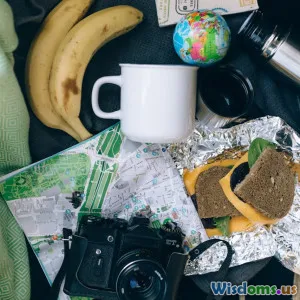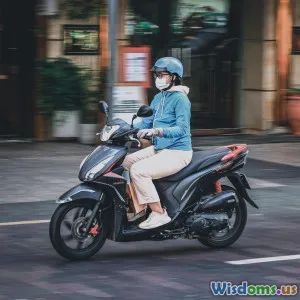
Packing Light for MonthLong Adventures A Detailed Breakdown
7 min read Master the art of packing light for month-long trips with practical tips and expert insights to travel effortlessly. (0 Reviews)
Packing Light for Month-Long Adventures: A Detailed Breakdown
Traveling for a month or longer can be thrilling, yet packing for such an extended period poses a significant challenge: carrying too much slows you down, but packing too little may leave you unprepared. Striking the perfect balance is key. In this detailed guide, we explore how to pack light for month-long adventures without compromising comfort or readiness.
Why Packing Light Matters for Long-Term Travel
Overpacking is more than an inconvenience; it's a burden. Lugging around excessive baggage can cause physical strain, hinder mobility, and limit spontaneity. In fact, Travel + Leisure reports that 70% of travelers regret overpacking due to the inconvenience and effort involved.
By packing light, you maximize freedom, reduce fatigue, and simplify logistics—whether hopping between cities, exploring rural landscapes, or bouncing between accommodations.
Mindset Shifts: Minimalism Meets Practicality
Before diving into what to pack, it’s vital to adopt the right mindset. Packing light doesn’t mean bringing just the bare minimum but selecting items carefully based on utility and adaptability.
- Focus on multipurpose gear. For example, a sarong can serve as a beach towel, scarf, or picnic blanket.
- Plan for layering. Weather can fluctuate; layering several thin, moisture-wicking pieces can replace bulky jackets.
- Be ready to do laundry. Carrying fewer clothes is manageable if you can wash regularly.
As Lori Haller, founder of the travel blog Chasing Feather, states, “Packing light is about quality and versatility rather than quantity. Each piece should earn its place in your bag.”
Core Categories For Your Packing List
1. Clothing Essentials
Choose fabrics that are lightweight, quick-drying, and wrinkle-resistant. Merino wool shirts, for example, naturally resist odors, allowing multiple wearings.
Consider these clothing tips:
- Pack 3-4 tops; preferably neutral-colored for mix-and-match outfits.
- Bring 2-3 bottoms: one pair of shorts, one lightweight long pant, and one versatile skirt or convertible pants.
- Include 1-2 layers like a fleece or lightweight jacket.
- Don’t forget simple items like underwear and socks—choose moisture-wicking materials.
Example: Experienced backpackers frequently carry blends like Merino wool t-shirts; they can be worn on day one, day five, and are still fresh.
2. Footwear
Select footwear suited to your travel terrain but limit yourself to 2 pairs to save space and weight. For instance:
- One sturdy, comfortable walking shoe or sneaker.
- One pair of sandals or flip-flops for casual wear and showers.
3. Technology and Gadgets
While essential, technology can add weight. Bring only what you will consistently use:
- Smartphone with travel apps.
- Compact power bank.
- Lightweight universal charger.
Optional items like a laptop or e-reader depend on your travel needs but ensure to keep cables minimal.
4. Toiletries and Health Items
Transfer liquids into travel-sized containers and opt for solid alternatives when possible (e.g., shampoo bars). A small first-aid kit with basics like plasters and antiseptic wipes is indispensable.
5. Miscellaneous Must-Haves
Don’t overlook items like a reusable water bottle, travel towel, and packing cubes. Packing cubes help compress clothes and keep your bag organized—vital when on the move!
Smart Packing Strategies
Roll, Don’t Fold
Rolling clothes tightly reduces wrinkles and saves space. A study by the University of Leeds showed this method can reduce garment volume by up to 33%.
Use Compression Bags
For bulkier items like jackets or sleeping bags, compression sacks can significantly minimize space.
Prioritize Accessibility
Keep essentials like documents, medication, and chargers in an easily reachable compartment.
Plan Your Laundry Routine
Research accommodations or local facilities where you can do laundry every 5-7 days to maintain a smaller wardrobe without stress.
Real-World Insight: Month-Long Adventure Success Stories
Case Study: Sarah’s Southeast Asia Trek Sarah packed a 10 kg bag (including electronics) for five weeks exploring Thailand and Vietnam. Her secret was versatile layering clothes and daily laundry in guesthouses. She credits her merino wool tee and multi-purpose sarong for comfort and style.
Data Point: Studies show travelers who pack under 12kg tend to report less back pain and higher satisfaction during long trips.
A traveler interviewed by National Geographic Adventure said, “Having a lighter pack changed how I traveled; I could board buses easily, explore on foot without strain, and felt more connected to the places I visited.”
Conclusion: Embrace the Freedom of Traveling Light
Packing light for a month-long adventure is as much about preparation as it is about mindset. By selecting versatile, quality items, minimizing non-essential baggage, and strategizing laundry and organization, you can transform your trip into a liberating experience.
Remember, every item you carry serves a purpose—choose wisely, pack smart, and set off on your journey unburdened and ready to immerse yourself in new experiences.
_Ready to lighten your load? Start by reviewing your current packing habits today and experiment with these game-changing tips on your next adventure.
Rate the Post
User Reviews
Popular Posts





















